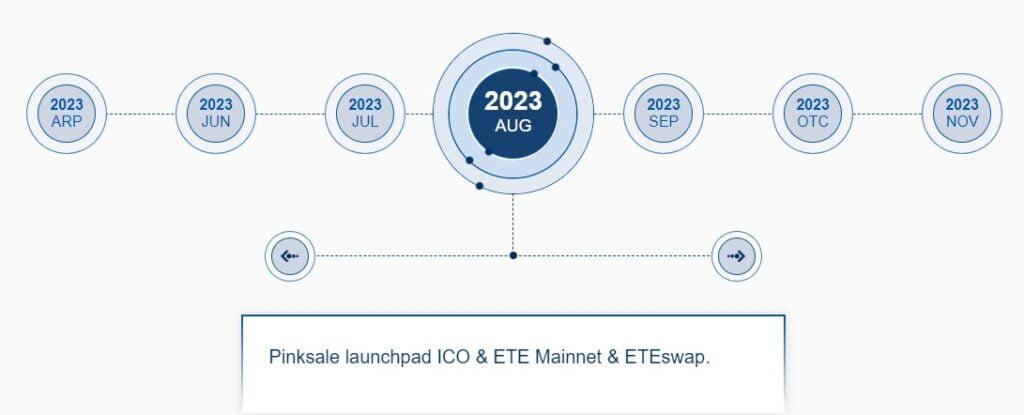Ethereum Express: In this article, we cover a detailed review of Ethereum Express. How does Ethereum Express Crypto work & Are important features?
About Ethereum Express
With more applications and smart contracts being deployed across the Ethereum network, its resources have become significantly stretched. Due to increased demand, congestion issues have arisen resulting in slower transaction confirmation times and significantly higher GAS fees for transfers and contract interactions.
Faced with these difficulties, layer 1 solutions such as Ethereum Express Network have emerged as competitive and advantageous alternatives. These layer 1 solutions focus on optimizing Ethereum’s core infrastructure to enhance scalability, reduce gas costs, and enhance overall performance – thus becoming integral players in maintaining Ethereum’s ability to meet the growing number of decentralized apps and smart contracts.
Ethereum Express Point Table
| Coin Basic | Information |
|---|---|
| Coin Name | Ethereum Express |
| Short Name | ETE |
| Total supply | 200M ETE |
| Max Supply | 200M ETE |
| Official Project Website | Click Here To Visit Project Website |
Ethereum Express Price Live Data
What is the Ethereum Express network?
The Ethereum Express network is a faster, safer, and cheaper L1 network based on the underlying framework of the Ethereum EVM.
How It Work
The Ethereum Express Network serves as a layer 1 solution to address the challenges posed by Ethereum network’s expanding ecosystem, with new applications and smart contracts leading to increased resource consumption leading to network congestion.
Congestion leads to higher GAS fees, making transactions and contract executions more expensive for users. Ethereum Express Network steps in as an attractive, cost-efficient alternative by optimizing Ethereum’s core infrastructure itself.
Scalability and efficiency enhancements at the layer 1 level aim to alleviate congestion, decrease GAS consumption and enhance performance for a smoother user experience – this approach ensures Ethereum can keep supporting an increasing number of decentralized apps and smart contracts without costing more in energy consumption or transaction fees.
Features
Enhance Scalability
Layer 1 solutions are intended to significantly increase the scalability of Ethereum blockchain, allowing it to process more transactions and smart contracts per second.
Reduced GAS Costs
By optimizing underlying infrastructure, layer 1 solutions aim to lower GAS fees for users, making transactions and contract executions more cost-efficient.
Improved Throughput
Layer 1 solutions enhance network throughput, enabling faster transaction confirmation times and better overall performance during periods of high demand.
Enhance Security
These solutions prioritize security while upholding the integrity of the Ethereum network, while adding scalability enhancements.
Interoperability
Layer 1 solutions are typically developed with interoperability in mind, to ensure compatibility with existing Ethereum smart contracts and applications.
Decentralization
They seek to preserve the decentralized principles of Ethereum while also addressing congestion issues.
Compatibility
Layer 1 solutions strive to be compatible with Ethereum’s current infrastructure and developer tools, offering users and developers an effortless transition experience.
Economic Efficiency
By lowering GAS consumption and fees, layer 1 solutions help promote economic efficiency within the Ethereum ecosystem, encouraging more people to join its network.
Long-Term Viability
Solutions constructed with long-term viability in mind are built with the aim of adapting to meet the changing demands of Ethereum network users and their ecosystem.
Community Support
Layer 1 solutions often enjoy strong community support and engagement, helping foster collaboration and innovation within the Ethereum ecosystem.
Roadmap

Meet Team

Conclusion
Conclusion – Ethereum network’s unprecedented surge in app and smart contract usage has resulted in increasing congestion and GAS consumption. As a way to overcome these challenges, layer 1 solutions like Ethereum Express Network have proven themselves effective and promising solutions. These solutions offer several features to enhance scalability, lower GAS costs and increase throughput while being compatible with existing Ethereum infrastructure.
Prioritizing both performance and decentralization, layer 1 solutions contribute to the long-term viability of Ethereum while allowing users and developers to take full advantage of its capabilities without hindering congestion. As Ethereum continues to develop, layer 1 solutions could play a pivotal role in maintaining its relevance within decentralized applications and smart contracts.
FAQ
What is the Ethereum Express Network, and how does it relate to Ethereum congestion?
The Ethereum Express Network is an example of a layer 1 solution designed to address congestion and scalability issues on the Ethereum network. It aims to provide a more efficient and cost-effective environment for executing transactions and smart contracts, especially during times of increased resource usage.
What is Ethereum congestion, and why does it occur?
Ethereum congestion occurs when there is a significant increase in the number of transactions and smart contracts being processed on the Ethereum network. This high demand for network resources leads to slower transaction confirmation times and higher GAS fees.
How do layer 1 solutions alleviate Ethereum congestion?
Layer 1 solutions like the Ethereum Express Network enhance the Ethereum blockchain’s core infrastructure to improve scalability, reduce GAS costs, and increase throughput. They optimize the network’s capacity to handle more transactions and smart contracts efficiently.
Are layer 1 solutions compatible with existing Ethereum applications and smart contracts?
Yes, layer 1 solutions are designed to be compatible with Ethereum’s existing infrastructure and developer tools. They ensure a seamless transition for users and developers, maintaining interoperability with the Ethereum network.
Do layer 1 solutions compromise decentralization or security?
Layer 1 solutions prioritize maintaining the decentralization and security principles of the Ethereum network. They aim to enhance performance while upholding the network’s core values and security standards.







